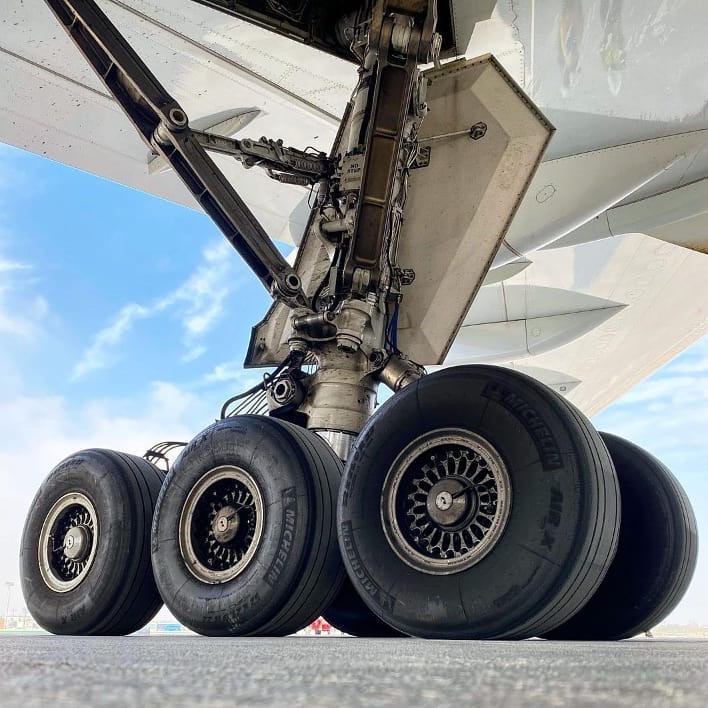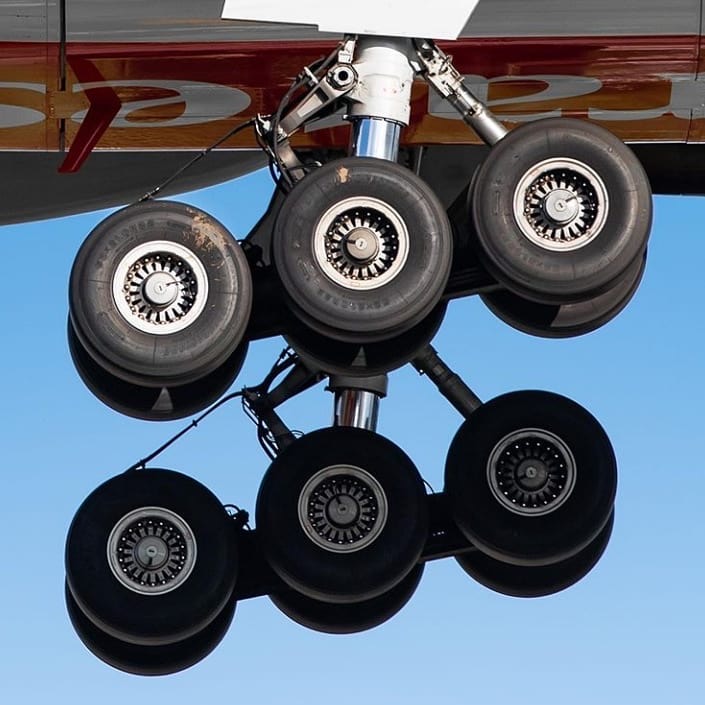The number of tires of civil aircraft landing gear is not arbitrary, but carefully designed according to the maximum take-off weight, landing weight, runway carrying capacity and safety redundancy of the aircraft.
Simply put, the heavier the plane, the more tires are needed. But the specific layout is also very particular.
The following is an overview of the number of landing gear tires of different types of civil aircraft:
1. Single-channel narrow-body airliner (commonly used in medium and short-haul routes)
This type of aircraft usually adopts a "front three-point" landing gear layout: a front landing gear and a main landing gear.
· Airbus A320 series (A318, A319, A320, A321):
· Front landing gear: 2 tires (single wheel)
· Main landing gear: 4 tires (one landing gear on each side, with 2 tires side by side on each landing gear, called "double wheels")
· Total number of tires: 2 + 4 = 6
· Boeing 737 series:
· The layout is exactly the same as that of the A320 series.
· Front landing gear: 2 tires (single wheel)
· Main landing gear: 4 tires (double wheels)
· Total number of tires: 6
2. Wide-body passenger aircraft (commonly used on medium and long-range routes)
This kind of aircraft is heavier and needs more tires to spread the weight.
· Boeing 777:
· Its main landing gear is very unique, with three tire axles.
· Front landing gear: 2 tires (single wheel)
· Main landing gear: 12 tires (one landing gear on each side, with three pairs (6) tires on each landing gear, called "three axles and six wheels")
· Total number of tires: 2 + 12 = 14
· Note: The main landing gear of the Boeing 777-300ER even has a variant of 6-axles and 12 wheels, with a larger total number of tires.
· Airbus A330 / Boeing 787:
· Front landing gear: 2 tires (single wheel)
· Main landing gear: 8 tires (one landing gear on each side, with two pairs (4) tires on each landing gear, called "double-axle four wheels")
· Total number of tires: 2 + 8 = 10
· Boeing 747 ("Queen of the Air"):
· Have a unique fuselage center landing gear to share the huge weight.
· Front landing gear: 2 tires (single wheel)
· Main landing gear (under the wing): 8 tires (two pairs (4) tires on each side)
· Fuselage center landing gear: 4 tires (two-axle and four-wheel)
· Total number of tires: 2 + 8 + 4 = 14 (slightly different models)
· Airbus A380 (the largest passenger aircraft at present):
· It has one of the most complex landing gear systems, with a total of 5 landing gears.
· Front landing gear: 2 tires (single wheel)
· Main landing gear (under the wing): 12 tires (one landing gear on each side, two rows on each landing gear, three wheels in each row, a total of 6 tires)
· Fuselage center landing gear: 8 tires (two front and rear landing gears, each with 4 tires)
· Total number of tires: 2 + 12 + 8 = 22
· Bombardier CRJ Series / PA Industry E-Jets Series:
· Front landing gear: 2 tires (single wheel)
· Main landing gear: 4 tires (double wheels)
· Total number of tires: 6 (the same as the number of A320/737, but the tire size is much smaller)
· ATR 72 / Bombardier Q400 (vortex aircraft):
· Front landing gear: 2 tires (single wheel)
· Main landing gear: 4 tires (double wheels)
· Total number of tires: 6
Summary form
Aircraft type Typical model Number of front landing gear tires Number of main landing gear tires Total number of tires
Branch airliner BAAS Industrial E190 2 4 6
Single-channel airliner Airbus A320, Boeing 737 2 4 6
Medium-sized wide-body airliner Airbus A330, Boeing 787 2 8 10
Large wide-body airliner Boeing 777 2 12 14
Super-large wide-body airliner Boeing 747 2 12 14
Super-large wide-body airliner Airbus A380 2 20 22
Why do you need so many tires? The main reasons are as follows:
1. Distributed pressure (pressure): According to the physical formula, pressure = pressure / force area. The weight (pressure) of the aircraft is fixed, and increasing the number of tires is equivalent to increasing the total grounding area, thus greatly reducing the pressure on the runway and preventing crushing the runway.
2. Provide redundant safety: In case a tire is flat during takeoff or landing, other tires can still bear the weight, ensuring the safe taxiing and stopping of the aircraft, which greatly improves safety.
3. Improve braking and cornering performance: More tires mean that more brake discs can be installed to provide stronger braking power. For the front landing gear, the double-wheel design can also provide better cornering stability.
4. Meet the requirements of the airport level: the runway and taxiway of the airport have a strict load-bearing level (PCN), and the pressure (ACN) of the aircraft on the road surface must be lower than this value to take off and land. Multi-tire design is the key to meet the requirements.
I hope this detailed explanation can help you understand the mystery of the number of tires in civil aircraft!


